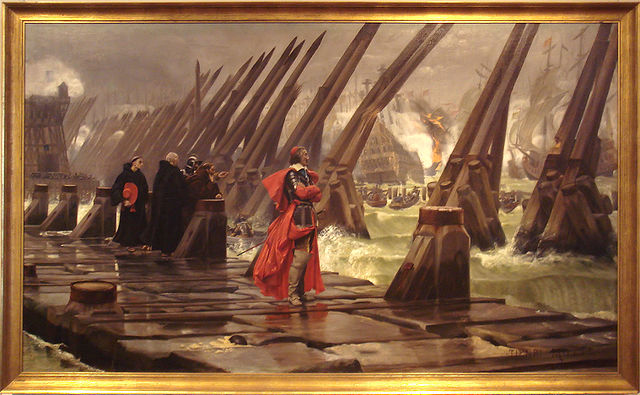*Image Credit: Wikimedia Commons Surrounded by the armies of King Louis XIII for 14 months, the Protestant Christians known as the Huguenots surrendered to the monarchy on October 28, 1628, ending the Siege of La Rochelle. Though the conflict stemmed from religious disagreements, the larger result was a solidification of the House of Bourbon’s rule over France — a reign that would come to define the nation well into the 19th century. Halfway through the 1500s, as the Reform movement began sweeping through Europe, a group of French Christians pulled away from the Catholic Church. Driven by the writings of John Calvin, the separatists were soon launching verbal assaults against the excesses emanating from Rome. The conflict became physical in time, with the Catholics attempting to disrupt Reform worship gatherings by any means necessary and the Huguenots responding with violence. At the height of the French Wars of Religion, as many as 30,000 Protestants were killed by Catholic mobs during the Bartholomew’s Day Massacre of 1572. Early in 1598, after a period of relative stability, King Henry IV — Louis XIII’s father — issued the Edict of Nantes. The law established the Roman Catholic Church as the official French religion, but allowed Huguenots to practice as they saw fit from their homes in southern France. La Rochelle, a city on the coast, became the de facto capital of Huguenot territory, growing to a population of approximately 27,000 by the 1620s. After his father’s assassination, Louis brought a firmer hand to the throne. Determined to suppress Protestant opposition, he worked in tandem with his primary advisor, Cardinal Richelieu, to make the destruction of the Huguenots the nation’s main priority. Hostilities began during the spring of 1627 and, with the rebels backed into La Rochelle by September, it seemed only a matter of time before the goal was achieved. The Huguenots trapped in the city held out hope of reinforcements. With much of the Protestant population in La Rochelle, however, those in outlying areas found it difficult to raise a competing army. The English, aiming to undermine the French government, attempted to deliver supplies to the port three separate times, getting some supplies through on the first try. Unable to break through the sea wall and a string of Dutch and Spanish ships under French control in subsequent trips, the Huguenots watched the English turn back from within the city. On October 28, 1628, the 5,000 remaining citizens of La Rochelle surrendered. Mayor Jean Guitton had seen 80 percent of the population die under the pressure of Catholic cannons and simple starvation. The Huguenots gave up their right to anything other than religious freedom in agreeing to the Peace of Alais, subjecting themselves to the monarchy without conditions. King Louis XIII had established himself as the supreme power in France, giving the line of kings to follow unchecked authority over the people. The Huguenots soon faced persecution again, when Louis XIV repealed the Edict of Nantes proclaimed by his grandfather and encouraged Catholics to attack Protestants with renewed force in 1685. Also On This Day: 1707 – An earthquake near Hoei causes 5,000 Japanese deaths 1886 – The Statue of Liberty is dedicated in New York Harbor 1922 – Benito Mussolini leads the March on Rome, gaining power for Italian Fascists 1962 – Soviet leader Nikita Khrushchev announces the removal of missiles from Cuba 1995 – The Baku Metro fire results in 289 deaths, the worst subway disaster in history
October 28 1628 CE – The Huguenots Surrender to End the Siege of La Rochelle
*Image Credit: Wikimedia Commons Surrounded by the armies of King Louis XIII for 14 months, the Protestant Christians known as the Huguenots surrendered to the monarchy on October 28, 1628,…
354
